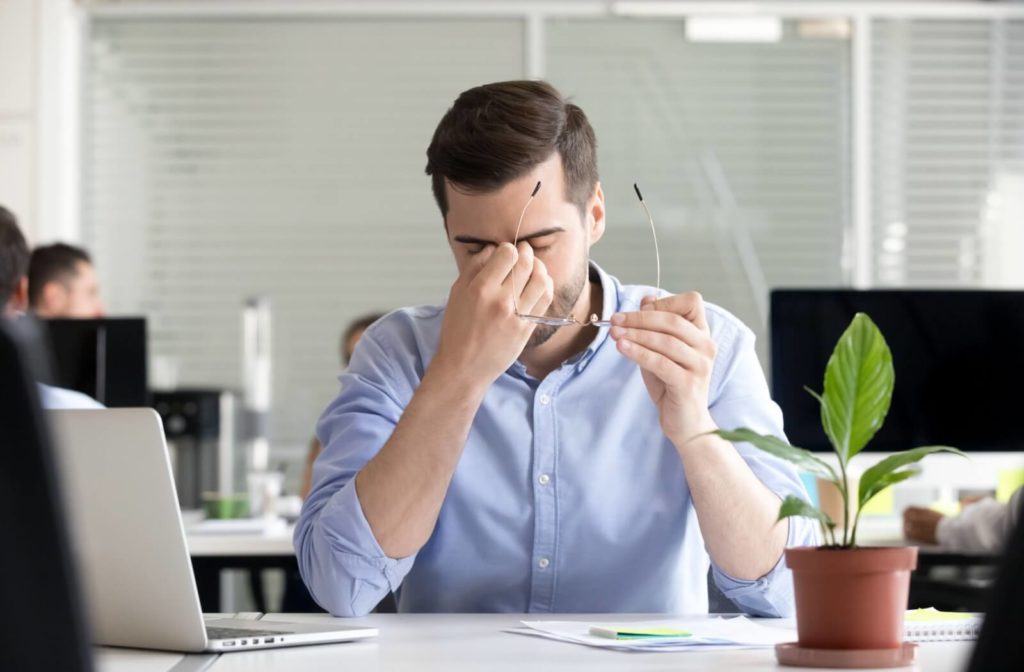If you’ve ever noticed a dull throb in your eyes when working at a screen, you’re not alone. The culprit was likely digital eye strain—an eye condition caused by too much time spent focusing. It’s a common problem, and it makes everyday tasks much more uncomfortable. So how long does this last, and what can you do about it?
Digital eye strain tends to last for a few hours. In the meantime, it helps to take a break and rest your eyes—try avoiding screens where possible and regularly focusing your eyes at different distances. This gives them a much-needed rest.
What Causes Eye Strain?
Our eyes rely on tiny focusing muscles every day. These muscles are responsible for helping you hone in your vision at different distances. Whenever you’re seeing something clearly, these muscles are at play—they’re a critical part of your visual system.
Whenever you’re working on nearby tasks, like reading or using a computer, you’re putting significant strain on these muscles. If you don’t give them a regular break, they can become overwhelmed. If you continue to overwork them, your eyes will eventually struggle to stay focused. This is eye strain.
Eye strain becomes much worse if you’re in a particularly harsh environment. If your lighting or ergonomics are off, it means your eyes have to work harder to do their job. This eventually leads to persistent irritation and strain.
The Common Symptoms of Eye Strain
The first step to managing eye strain is knowing when it develops. It’s not limited to just screens and can develop due to any task requiring intense focus. Eye strain often starts subtly and slowly worsens over a short time, so watch for signs like:
- Headaches
- Blurred or double vision
- Difficulty concentrating
- Sensitivity to light
- A heavy, dull throb in the eyes
- Back, neck, and shoulder pain
- Fatigue
You might not experience every symptom at once. However, even just one or two eye strain symptoms can disrupt your focus. If you notice that such symptoms develop when you’re using a computer or focusing on nearby tasks, it’s time to think about making changes to your routine.
Does Eye Strain Go Away on Its Own?
In most cases, eye strain resolves on its own. It just takes a bit of time—you need to give your eyes the break they’re asking for. Symptoms usually go away within a few hours or so.
First, try shifting your focus every few minutes. Even just looking out the window every few minutes helps relieve strain. It gives your eyes a short rest and the chance to reorient themselves. Sometimes, that’s all you need.
However, persistent strain can sometimes indicate an underlying issue. If you ever notice significant discomfort, pain, or stinging sensations, visit your optometrist. These symptoms can be a sign of a condition like chronic dry eyes.
Does Eye Strain Cause Dry Eyes?
When using screens, many people notice dry eyes. This is another common eye condition caused by imbalances in your tear film. It often causes blurry vision, excessive tearing, and inflammation. So why does this develop?

Though dry eyes and eye strain occur together, one doesn’t directly cause the other. They instead share a common factor—periods of intense focus without proper rest. For dry eyes, this often develops due to blinking habits.
When you’re looking at a screen or focusing on something close, your blink rate naturally slows down. We naturally blink around 15-20 times per minute—but when using screens, this can drop to as little as 4 times per minute.
This means your tears need to work harder to protect your eyes, which ultimately causes irritation. Fortunately, with a few small changes, you can reduce the symptoms of both eye strain and dry eye.
Tips for Preventing Eye Strain
Preventing eye strain is often easier than dealing with symptoms once they develop. It’s all about being proactive and keeping your eyes comfortable. This starts with your habits and environment.
To prevent eye strain, try to:
- Follow the 20-20-20 rule. Every 20 minutes, look at something 20 feet away for at least 20 seconds.
- Match your screen brightness and contrast to the lighting in your space.
- Use artificial tears or a humidifier to avoid dryness in your eyes.
- Adjust your chair and monitor to create an ergonomic workspace that supports good posture.
- Take regular breaks away from screens or tasks that require intense focus.
Following the above tips will help reduce daily demands on your vision. These changes can be all it takes to reduce your everyday strain.
Dealing With Eye Strain? We Can Help
Eye strain might be temporary, but it’s still an everyday problem. You don’t deserve strain and irritation—not when they’re preventable. Maintaining your eye health and comfort doesn’t have to be complicated, and our team at Bayside Eye Care is here to help. Contact our team today and book your appointment, and let our team help you find the comfort you deserve.



